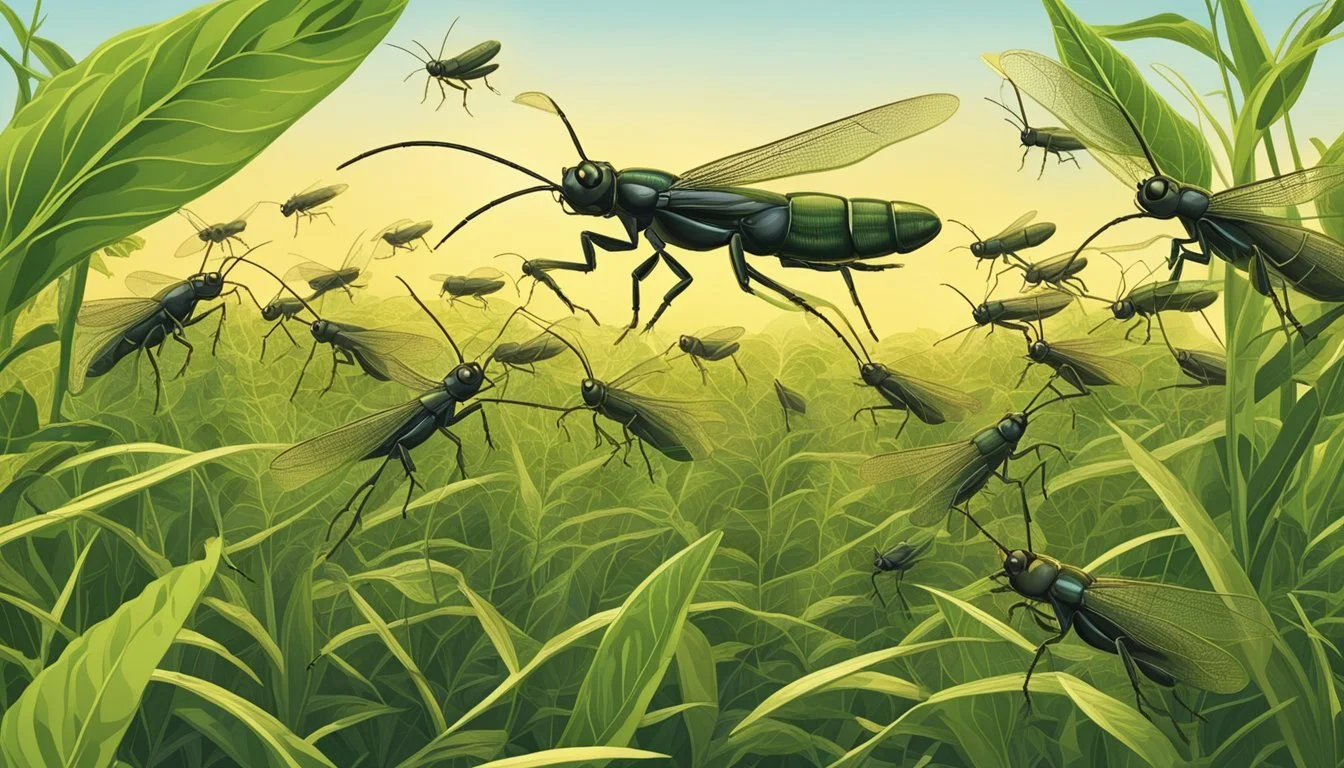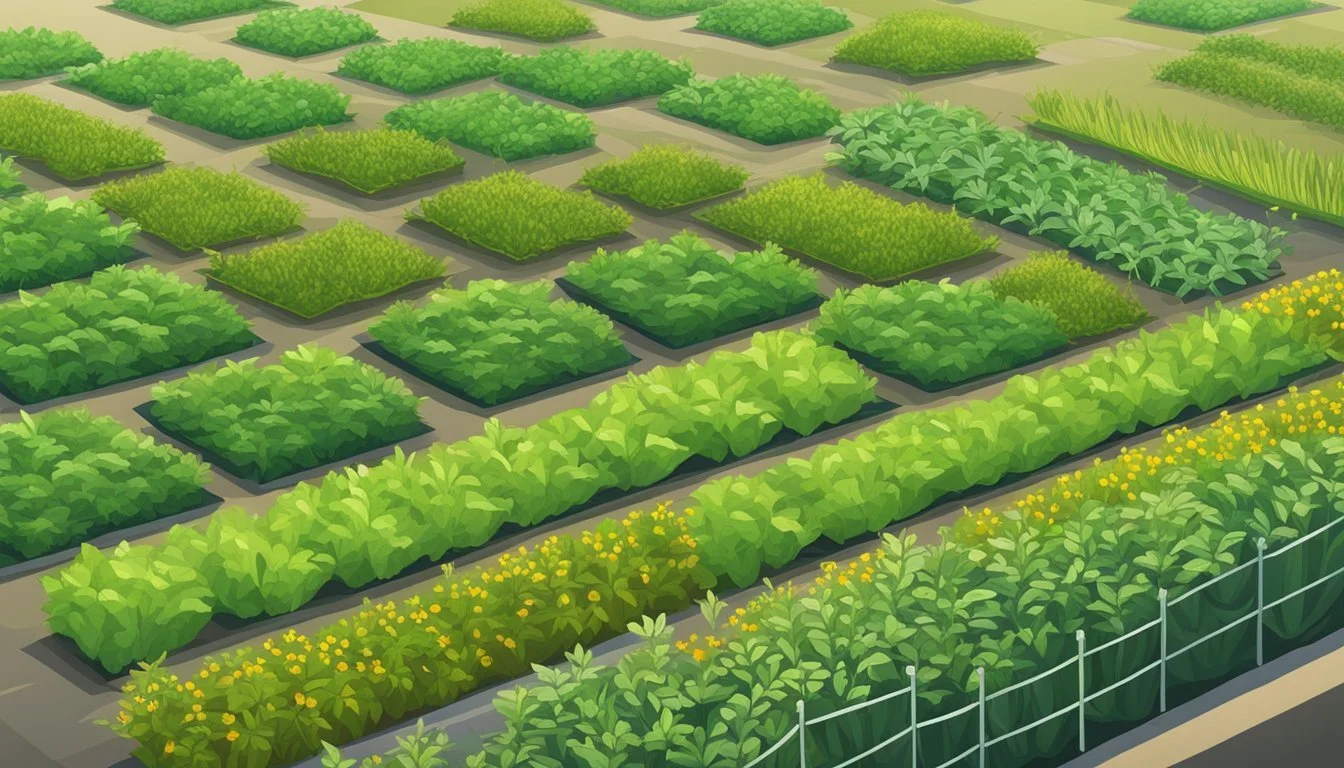Protecting Crops from Differential Grasshopper
Effective Control Strategies
The Differential grasshopper, scientifically known as Melanoplus differentialis, poses a significant threat to a wide range of agricultural crops. Farmers often encounter these voracious insects feeding on plants such as small grains, corn (how long does corn last?), alfalfa, soybeans, and cotton. Due to their high reproductive capacity and ability to consume large amounts of foliage, Differential grasshoppers can inflict serious damage to crop yields, leading to substantial economic losses.
Effective management and control of this pest are vital for protecting crops and ensuring farm sustainability. An integrated pest management approach, which includes regular monitoring and timely intervention, can help mitigate the impact of grasshopper infestations. Farmers may need to employ a variety of control measures, from cultural practices to chemical treatments, to safeguard their fields from the potentially devastating effects of grasshopper populations.
Understanding the biology and behavior of Differential grasshoppers is crucial in developing strategies to combat them. They typically lay their eggs in undisturbed soil, and populations can fluctuate based on environmental conditions. Field surveys conducted early in the growing season can be instrumental in predicting and preventing grasshopper outbreaks. By taking proactive measures, farmers can reduce the risk of heavy infestations and protect their crops from these persistent pests.
Understanding the Differential Grasshopper
In addressing the challenge of protecting crops, it is crucial to understand the specifics of the Differential Grasshopper, a species known for its impact on agriculture.
Species Identification and Characteristics
The Differential Grasshopper, Melanoplus differentialis, is an insect recognized by its brown to olive green body with pronounced yellow markings and wings. Adults can reach lengths of up to 1-3/4 inches. A distinct characteristic is the hind legs, which are marked with chevron-like black markings, and are substantial in size to aid in jumping. This species can be mistaken for the closely related twostriped grasshopper and redlegged grasshopper; however, it can be distinguished by its specific color patterns and larger size.
Life Cycle and Developmental Stages
The life cycle of the Differential Grasshopper undergoes metamorphosis in stages from egg to nymph to adult. A single female may deposit 45 to 194 eggs in soil pods, which show resilience in various environmental conditions. The development of this grasshopper is temperature-dependent, requiring significant heat units, which consequently means higher activity and impact in warmer regions.
Habitat and Geographic Distribution
Primarily residing in temperate regions, the Differential Grasshopper has a habitat range that extends more to the south compared to its relatives. This species is prevalently found in agricultural fields, where it can become a severe pest, feasting on crops such as grains, corn, alfalfa, cotton, soybeans, and various vegetables. Their geographic distribution often overlaps with other grasshopper species, leading to combined outbreaks that can amplify damage to crops. Effective control strategies often involve monitoring and the targeted use of insecticides to mitigate their impact on crop production.
Assessing Grasshopper Damage
Effective management of grasshopper populations begins with accurately assessing their impact on agriculture. This includes identifying the affected crops, recognizing signs of grasshopper infestations, and predicting potential outbreaks.
Impact on Various Crops
The Differential grasshopper is known to affect a wide range of field crops, including corn, wheat, alfalfa, soybeans, and small grains. In particular, areas within the Great Plains—states like Oklahoma, Nebraska, and Colorado—often experience significant grasshopper damage in both forage and pasture lands as well as in cropland. Adult grasshoppers consume large amounts of foliage, which can lead to considerable yield losses.
Signs of Infestation and Damage Identification
Nymphs and adult grasshoppers both contribute to damage, though their feeding patterns may differ. Identification of grasshopper damage often includes:
Chewed leaf margins on plants.
Skeletonized leaves, where only the veins remain.
Consumption of the soft tissue between the veins of leaves, giving the crop a lacy appearance.
The presence of nymphs is a key indicator of developing problems, as infestations start with these immature stages.
Monitoring and Prediction of Outbreaks
Monitoring involves regular field scouting to count nymph and adult population densities. The findings help to predict the timing and potential scale of outbreaks.
Historical data and weather patterns are used to assess the risk of future outbreaks, as both can influence grasshopper population growth. The frequency and intensity of outbreaks have been documented as higher in regions like the Great Plains due to favorable grasshopper breeding conditions.
Early detection and timely intervention are crucial for protecting crops from escalating damage.
Grasshopper Management Strategies
Effective management of differential grasshoppers involves a range of strategies that target various stages of their lifecycle. By employing cultural, biological, and chemical control methods tailored to specific environments such as rangeland or field margins, significant protection of crops can be achieved. Integrated Pest Management (IPM) principles may guide the application of these strategies to maximize efficacy while minimizing environmental impact.
Cultural Control Methods
Cultural controls alter the environment to reduce the habitability for grasshoppers. Managing vegetation along roadsides and ditches can decrease egg-laying sites and limit grasshopper populations. Modification of field margins by reducing weeds can also be beneficial by making areas less attractive for grasshoppers.
Biological Control Techniques
Biological control leverages natural enemies of the differential grasshopper to keep their numbers in check. Birds and predators in Nebraska and Colorado are crucial allies in this approach. The introduction of pathogens like Nosema locustae is another method, aimed at infecting grasshopper populations and reducing their ability to thrive in rangelands and croplands.
Chemical Control Options
When grasshopper populations exceed threshold levels, chemical controls may be needed. Insecticide treatment options include seed treatments, foliar insecticides, and the use of specific chemicals such as carbaryl and synthetic pyrethroids. These treatments should be applied judiciously to avoid harming non-target species and to prevent the development of resistance.
Integrated Pest Management (IPM)
IPM combines cultural, biological, and chemical methods for comprehensive grasshopper control. This strategy focuses on sustainable pest control that balances effective management with environmental conservation. It emphasizes regular monitoring of grasshopper populations, using economic threshold levels to determine when to employ control measures and relying on a variety of practices to manage pests over the long term.
Effective Monitoring and Scouting Techniques
Effective management of Differential grasshopper populations in cropland hinges on early detection and accurate assessment of their numbers relative to economic thresholds which tell when it's cost-effective to take action.
Establishing Economic Thresholds for Treatment
Setting economic thresholds for treatment is critical in grasshopper management. They determine the density at which grasshoppers become economically harmful and control measures should be considered. For example, the United States Department of Agriculture (USDA) suggests action is warranted when there are 8-10 adults or 15-20 nymphs per square yard in grasslands. Thresholds can vary based on the crop variety and the growth stage; hence, local extension services should be consulted for specific figures.
Scouting Methods and Timing
Scouting for Differential grasshoppers should begin in early spring, as this is when eggs hatch and nymphs start to emerge. Because grasshoppers undergo several molts before reaching adulthood, scouting should continue through the season to monitor successive generations. North Dakota State University advises that field scouting focus not only on the edges but also on the interior of fields where grasshoppers may migrate as they develop.
Utilizing Sweep Nets for Grasshopper Sampling
A sweep net is a practical tool for sampling grasshopper populations. When using a sweep net, a standard approach involves taking sweeps of a consistent size and speed through vegetation. Then, the numbers of nymphs and adults caught can estimate the population density within that area. For instance, the University of Nebraska-Lincoln's CropWatch program recommends a systematic approach to sweeping with set sweeps at regular intervals to provide a representative sample of grasshopper populations, facilitating accurate decision-making regarding control measures.
Special Considerations for Specific Crop Types
When managing the Differential grasshopper, one must take into account the unique vulnerabilities and defensive strategies suitable for each crop. Given that grasshoppers can greatly vary in their feeding habits, special considerations should be tailored to protect wheat, corn, sorghum, and alfalfa effectively.
Grasshopper Management in Wheat and Small Grains
Wheat and small grains like barley and rye often face substantial risk from grasshopper infestations. In wheat, especially winter wheat, emerging seedlings can be decimated by grasshopper feeding. To mitigate this risk, farmers should monitor grasshopper populations at the edges of fields and use targeted controls before migration into the crop occurs. Baits containing insecticides may be effective if applied in surrounding non-crop areas where grasshoppers congregate.
Addressing Grasshopper Threats in Corn and Sorghum
Corn and sorghum can suffer notable crop loss when grasshopper populations are high. The insects tend to feed on the leaves and can sometimes clip corn silks, which affects pollination and kernel development. Farmers should scout fields regularly, looking for grasshopper presence as the corn begins to silk and sorghum starts to head. Control measures might include applying insecticides during early infestation stages.
Protective Measures for Alfalfa and Legumes
Alfalfa and legume crops are highly palatable to grasshoppers and require vigilant protection strategies. Regular field inspection is crucial, as grasshoppers can quickly defoliate these plants, leading to significant yield reductions. One should consider early-season habitat management to limit grasshopper breeding sites and early intervention with insecticides or bait applications when thresholds exceed economically damaging levels.
Frequently Asked Questions
This section addresses common inquiries about mitigating the threats posed by the Differential grasshopper to agricultural operations, detailing preventive strategies, recognizing signs of infestation, and exploring eco-friendly pesticide options.
What are the most effective methods for controlling grasshopper populations in agricultural areas?
Cultural controls and the application of insecticides are among the most effective strategies for controlling grasshopper populations. Strategies include tillage to disrupt egg laying, crop rotation to reduce the continuity of food sources, and the use of chemical controls when necessary. Early intervention is key to prevent large infestations.
Which specific crops are more susceptible to damage by grasshoppers?
Grasshoppers typically feed on a variety of crops, with cereals, corn, and alfalfa being particularly vulnerable. The Differential grasshopper is known to have a high biotic potential which can lead to significant damage if not effectively managed.
What are the signs that crops have been damaged by grasshoppers?
Signs of grasshopper damage include chewed leaves, stems, and sometimes fruit. The presence of grasshoppers themselves can also be a sign, as they are typically visible on the damaged plant or in the area. Monitoring for these indicators is critical for early detection.
How can farmers identify and manage grasshopper infestations in their fields?
Farmers can manage grasshopper infestations by regular field scouting to identify the presence of these pests and assess their population density. Control measures such as chemical, biological, or cultural should be tailored based on the level of infestation and the specific crop requirements. The USDA APHIS provides valuable resources for grasshopper management.
What role does the gizzard play in the grasshopper's digestive system, and how does it affect crop consumption?
The gizzard in grasshoppers grinds up plant material before it passes through the digestive tract. Their ability to efficiently break down fibrous plant tissues contributes to the high rates of consumption that can devastate crops.
Are there any environmentally friendly pesticides for targeting grasshoppers in crop protection?
Environmentally friendly pesticides, such as those derived from naturally occurring substances, are available for grasshopper control. For example, baits mixed with the biological insecticide Nosema locustae can target grasshoppers with minimal impact on other wildlife or the environment. Always consider integrated pest management practices to minimize ecological disruption.



